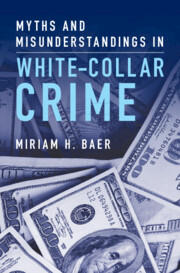Miriam Baer ’93 Unpacks the Pathologies of White-Collar Crimes in New Book
Editor's note: The original version of this article included an excerpt from the galley copy of the book. It has been updated to included language in the book's final copy, including that Aaron Swartz had reportedly broke into a digital academic library.
The book: Using real world examples, Miriam Baer ’93 explores the pathologies of white-collar crime in her latest book Myths and Misunderstandings of White-Collar Crime (Cambridge University Press). In it, Baer argues that several misinterpretations about white-collar crime account for its overcriminalization and underenforcement. These failures include not classifying white-collar crimes by degrees of severity in various jurisdictions, and not clearly defining crimes in statutes. Baer ultimately offers readers a guide to remedy these various myths and misunderstandings.

The author: Miriam Baer ’93 is the vice dean and centennial professor of law at Brooklyn Law School, where she teaches and writes at the intersection of business law and criminal misconduct. In addition to her new book, she is the author of numerous articles and book chapters on whistleblowing, corporate surveillance, and federal enforcement. Her work has been cited or excerpted in casebooks, treatises, and federal appellate judicial opinions. Prior to entering academia, Baer was an assistant general counsel for compliance with Verizon and a federal prosecutor in Manhattan, where she developed expertise in investigating and prosecuting white-collar crime. She is a co-editor of a leading white-collar crime casebook and study aide and has been quoted frequently by national media outlets. At home, she enjoys spending time with her husband and two children, and her labradoodle, Lucy.
Excerpt:
In January 2013, Aaron Swartz, a brilliant computer programmer and activist, died by suicide. At the time, Swartz’s prosecution for engaging in computer fraud – Swartz had reportedly broken into JSTOR, the digital academic library, and had made its content available to the public – was nearing trial in a Boston federal court. In the wake of Swartz’s death, critics vehemently blamed the prosecutors spearheading his case for charging him in a way that threatened to produce a potential jail sentence of thirty years’ imprisonment. The United States Attorney contended that Swartz in fact realistically faced no such sentence; indeed, the jail term prosecutors sought in exchange for Swartz’s guilty plea was a mere six months. Amidst this back and forth, Swartz’s case eventually receded into the background.
Nearly two years later, the Supreme Court heard arguments in the case of Yates v. United States. John Yates, a commercial fisherman, was charged with obstructing justice by disposing of a portion of the grouper he had caught while out at sea. Federal law prohibits the concealment or destruction of a “tangible object” to subvert a federal investigation. Yates’s case came about when a fisheries investigator boarded his ship and observed several pieces of grouper a few inches short of the size required by existing regulations. The investigator directed Yates to segregate the prohibited fish so that it could be weighed when the ship docked and Yates could be assessed an appropriate fine. When Yates’s ship returned to port, however, the grouper in the ship’s hold had magically grown in size. One of Yates’s crewmen admitted that he had, at Yates’s command, dumped the offending fish and replaced them with larger-size grouper. The obvious purpose in doing so was to avoid the fine.
Yates’s attorneys successfully persuaded the Supreme Court that undersized “fish” were not the “tangible objects” Congress had in mind when it criminalized the destruction of documents and other materials in anticipation of an investigation. Besides the inevitable fish puns, what caught the attention of at least one Supreme Court justice was the length of sentence Yates might receive if convicted: “What kind of mad prosecutor would try to send this guy up for twenty years?” Justice Scalia reportedly inquired during oral argument. Of course, Yates never realistically faced a twenty-year term. In fact, he received a sentence of just thirty days’ imprisonment. Nevertheless, the fact that Yates could have received such a sentence played a role in convincing a majority of the Court that Congress narrowly intended its statute to include documents or digital material when it adopted the term, “any tangible object.”
Yates’s prosecution and other cases discussed in this book underscore society’s conflicting attitudes toward the body of law many of us have come to call “white-collar crime.” On one hand, an unmistakable overcriminalization theme pervades popular and academic discourse. We seem to make a federal case out of everything – from a local fisherman’s decision to dump fish into the sea, to the prank one set of public officials decides to play on another.
At the same time, there is just as strong an impression that white-collar crime, particularly federal white-collar crime, is underenforced. Year in, year out, regardless of presidential administration, the federal government manages to overlook the most culpable players when it singles out businesspeople and politicians for prosecution. A few unlucky offenders find themselves at the end of the prosecutor’s proverbial gun, but the rest appear to escape responsibility for their reckless behavior. How can that be so?
Some contend that this juxtaposition demonstrates nothing more than class difference and political power. Well-heeled corporate executives escape accountability for imposing massive costs on society while prosecutors celebrate convictions of bit players in tawdry conspiracy schemes. Government enforcement agencies punch down and suck up. From this perspective, the remedy seems remarkably simple: the government must commit itself to punishing the powerful more often, strengthening the penalties it imposes on corporate executives, and avoiding low-level prosecutions that do little more than prop up annual statistics.
This book draws a different set of conclusions. Class differences matter in white-collar crime, but they don’t fully describe our government’s enforcement efforts, much less explain white-collar crime’s persistence. To our detriment, we have overlooked an alternative source of problems: our statutes and our legislature’s unwillingness to meaningfully reform them. Our broken federal criminal code fuels alternative narratives of overcriminalization and underenforcement and leaves us bereft of the tools necessary to address related but distinct categories of economic wrongdoing. Regardless of how one views criminal law’s mission, our white-collar statutes fail us as a society. They undermine our criminal justice system’s legitimacy and skew its signals. Rather than correcting or deterring wrongs our white-collar penal statutes ultimately confuse and mislead.
….
Government prosecutors cannot do justice if the public they serve misunderstands their processes and distrusts their motives. Policymakers should register alarm when a pernicious and reductive narrative takes hold, insisting that prosecutors are interested in little more than churning cases and revolving into more prestigious jobs in the private sector. It behooves us to figure out why the public has such a negative view of white-collar criminal enforcement. If this perspective is in fact erroneous, we should identify the phenomena that produce it and make it so difficult to dislodge.
Answering these questions leads not only to the dispelling of persistent myths, but also to the improvement of the institutions tasked with investigating and punishing white-collar crime.
Note: This excerpt has been published without citations or references.
Excerpted from Myths and Misunderstandings in White-Collar Crime by Miriam Baer. Copyright © 2023 Cambridge University Press. Reprinted with permission of the author.












No responses yet